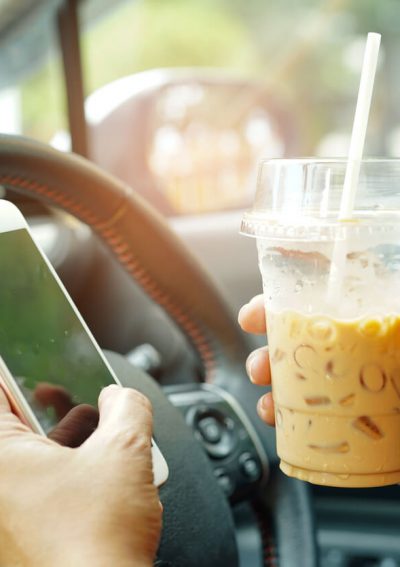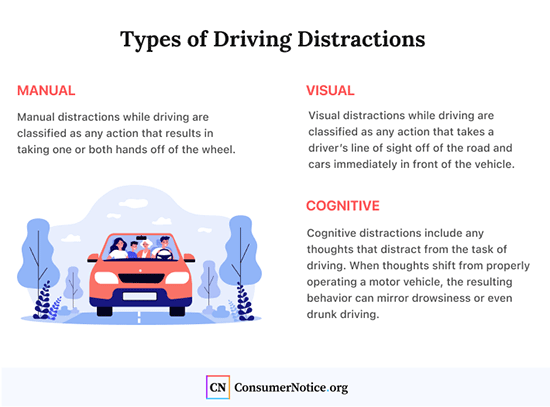Distracted Driving
Distracted driving is classified as any action taken while driving that does not involve operating the motor vehicle. The Centers for Disease Control & Prevention also defines this as any “activity that takes your attention away from driving.” This includes, but is not limited to, texting, eating, reaching for an object, as well as looking at and engaging with passengers beyond simple conversation.

In 2020, cell phones distracted 21% of teens involved in car accidents. According to the National Highway Traffic Safety Administration, 660,000 drivers use electric devices while driving. Using a device while driving can potentially take your eyes off the road for 5 seconds. Taking your eyes off the road for only two seconds doubles the risk of a crash. In 2019, 3,142 deaths resulted from distracted driving.
Types of Distractions While Driving
There are three main types of distractions while driving: visual, manual and cognitive. While these are different types of distractions, they can often happen in combination with each other. For example, texting while driving includes all three of these distraction types.
Visual Distractions
Visual distractions while driving are classified as any action that takes a driver’s line of sight off of the road and cars immediately in front of the vehicle. Even quick glances away from the road can result in an accident. The faster the car is moving, the further you travel while looking away.
- Changing the radio
- Reaching or looking for items in the vehicle
- Putting makeup on
- Adjusting temperature controls in the car
- Looking at roadside billboards
- Looking at a crash on the side of the road
- Looking at your phone
Visual distractions often overlap with manual distractions, as they require you to look at the object being used.

Manual Distractions
Manual distractions while driving are classified as any action that results in taking one or both hands off of the wheel. Manual distractions may also overlap with the other distraction types. For example, rolling down the window may require you to think about the window instead of driving, take your hand off the wheel to operate the window and look away from the road to find the button.
- Eating and drinking
- Smoking
- Texting
- Personal grooming, such as putting on makeup or brushing hair
- Reaching for an object
- Turning knobs in your car
- Tending to a child
- Looking through a purse or wallet
Manual distractions that mix with visual distractions are particularly dangerous because if a driver is no longer looking at the road and does not have both hands on the wheel, their ability to maneuver properly to avoid danger is severely reduced.
Cognitive Distractions
Cognitive distractions include any thoughts that distract from the task of driving. When thoughts shift from properly operating a motor vehicle, the resulting behavior can mirror drowsiness or even drunk driving.
- Talking with passengers
- Talking on the phone
- Reading texts, books or maps
- Daydreaming
It’s very important to avoid these distractions whenever possible, as it does not take more than a second for an accident to occur.
Dangers of Texting
Texting combines visual, manual and cognitive distractions and leads to a six times greater risk of crashing than drunk driving. According to the NHTSA, 2.8% of all drivers, around 360,000, engaged in texting while driving in 2020.
Each time a driver interacts with their phone, specifically to read or send a text message, the driver takes their eyes off the road for five seconds. In five seconds, a car traveling at or faster than 55 miles per hour will cover 300 feet or the length of a football field. In the U.S. texting while driving causes one out of every four car accidents, leading to nearly 390,000 injuries each year.
Preventing Distracted Driving
Strong legislation, raising awareness and open discussions with young drivers about traffic safety standards can help prevent distracted driving. A number of nonprofit organizations, phone companies and media outlets have run campaigns about the dangers of distracted driving.
Organizations such as Students Against Distracted Driving work to reduce distracted teen driving. The fatal crash rate for teens is three times greater than that for people 20 and over and 9% of all teens killed in car crashes were killed in distraction-related crashes.
States have made efforts to reduce cell phone use while driving, but no states completely ban cell phone use while driving. Texting while driving is banned in all states except Montana and Missouri. Hand-held phone conversations are banned in 24 states.
While 94% of drivers say they support a texting ban and 74% support a hand-held phone use ban, many admit they occasionally use their phone while driving. Determining the full impact after bans are put in place will take time to study, but high-visibility enforcement appears effective in lowering phone usage.
11 Cited Research Articles
Consumernotice.org adheres to the highest ethical standards for content production and references only credible sources of information, including government reports, interviews with experts, highly regarded nonprofit organizations, peer-reviewed journals, court records and academic organizations. You can learn more about our dedication to relevance, accuracy and transparency by reading our editorial policy.
- Dolman, Matt. (2021, February 11). 25 Distracted Driving Statistics [2021]. Retrieved from https://www.dolmanlaw.com/distracted-driving-statistics/
- Arevalo, Tony. (2021, February 9). 24 Distracted Driving Statistics & Facts (Updated for 2020). Retrieved from https://carsurance.net/blog/distracted-driving-statistics/
- National Highway Traffic Safety Administration. (2021). Driver Electronic Device Use in 2020. Retrieved from https://crashstats.nhtsa.dot.gov/Api/Public/ViewPublication/813184
- AAA. (n.d.). The Risks of Distracted Driving. Retrieved from https://exchange.aaa.com/safety/distracted-driving/the-risks-of-distracted-driving/
- Centers for Disease Control and Prevention. (n.d.). Distracted Driving. Retrieved from https://www.cdc.gov/transportationsafety/distracted_driving/index.html
- Edgar Snyder & Associates. (n.d.). Texting and Driving Accident Statistics. Retrieved from https://www.edgarsnyder.com/car-accident/cause-of-accident/cell-phone/cell-phone-statistics.html
- End Distracted Driving. (n.d.). Learn The Facts About Distracted Driving. Retrieved from https://www.enddd.org/the-facts-about-distracted-driving/
- Florida Highway Safety and Motor Vehicles. (n.d.). Put It Down: Focus On Driving. Retrieved from https://www.flhsmv.gov/safety-center/driving-safety/distracted-driving/
- Insurance Information Institute. (n.d.). Facts + Statistics: Distracted Driving. Retrieved from https://www.iii.org/fact-statistic/facts-statistics-distracted-driving
- National Highway Traffic Safety Administration. (n.d.). Distracted Driving. Retrieved from https://www.nhtsa.gov/risky-driving/distracted-driving
- The Insurance Institute for Highway Safety. (n.d.). Distracted driving. Retrieved from https://www.iihs.org/topics/distracted-driving
Calling this number connects you with a Consumer Notice, LLC representative. We will direct you to one of our trusted legal partners for a free case review.
Consumer Notice, LLC's trusted legal partners support the organization's mission to keep people safe from dangerous drugs and medical devices. For more information, visit our partners page.
844-420-1914
